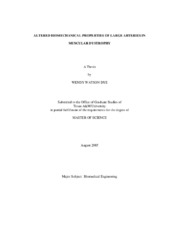| dc.description.abstract | Muscular dystrophy is a disease characterized by skeletal muscle weakness and wasting,
but little is known of alterations in the vascular system that occur with this disease. The culprit in
many muscular dystrophies is a defective dystrophin-glycoprotein complex (DGC). The DGC is
a group of transmembrane proteins that connects the cytoskeleton of muscle cells to the
extracellular matrix; it plays a role in mechanotransduction and the maintenance of structural
integrity of these cells, and includes the proteins dystrophin and sarcoglycan-delta. The absence
of these proteins results in severe muscular dystrophies in humans, and thus knockout mice
lacking the genes encoding for dystrophin (mdx mice) and sarcoglycan-delta (sgcd-/- mice) were
studied to detect any vascular alterations that occur as a result of a defective DGC. Acute biaxial
biomechanical data were obtained through pressure-diameter and axial force-length tests on
common carotid arteries of mdx, sgcd-/-, and wild-type mice in the active and passive smooth
muscle state. Functional response to the vasoreactive compounds phenylephrine,
carbamylcholine chloride, and sodium nitroprusside was also tested. We found significant
biomechanical differences between the knockout and wild-type mouse arteries: the mdx and
sgcd-/- arteries had decreased distensibilities in pressure-diameter tests, with mdx arteries also
having increased circumferential stresses, and the knockout arteries generated increased axial
loads and stresses in the axial force-length tests. The mdx and sgcd-/- arteries also differed from
the wild-type in that their ‘homeostatic’ axial stretch, at which the axial force remains constant upon pressurization, was significantly decreased. We conclude that the loss of DGC proteins
does trigger changes in vascular smooth muscle cells or their interactions with the extracellular
matrix, yet that the altered vascular system was able to adapt and function without the DGC.
Knowledge of alterations to the vascular system (and adaptations to these changes) of patients
with muscular dystrophy could help physicians customize their treatment to extend and enhance
their lives, especially as medical advances extend the lifespan of these patients and they begin to
suffer from diseases such as hypertension and atherosclerosis that affect the normal aging
population. | en |


